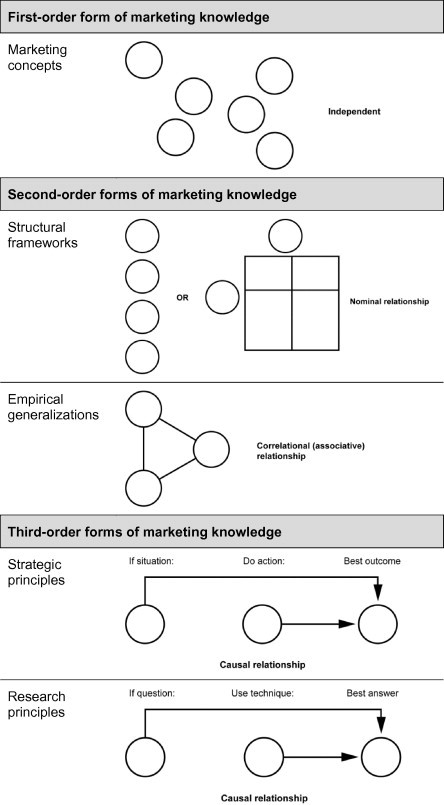You are being asked to make a theoretical contribution and to find theoretical research gaps. This can be a daunting task, especially when you don’t know what can be considered as a theory and what is not. This guide will point you in the right direction.
What is a theory?
A supposition or a system of ideas intended to explain something, especially one based on general principles independent of the thing to be explained (Oxford Dictionary, 2016).
Example: Darwin’s theory of evolution.
A theory can also be a set of principles on which the practice of an activity is based (Oxford Dictionary, 2016).
For example, if within marketing there are certain steps or principles to develop an advertising brief, and these principles are used by the majority of advertising practitioners, this could be part of the theory of advertising.
What is a model?
A simplified description of a system or process, to assist calculations and predictions (Oxford Dictionary, 2016).
Examples: Product life cycle model, the AIDA model
Within the universe of theories and models, there are different orders that go from the ones to refer to marketing concepts, to second and third-order models. Ideally, in your dissertation, you would be aiming to find gaps in second and third-order models. The reason is that to come up with purely conceptual theories are harder to devise for inexperienced researchers.
Sometimes, when you are doing exploratory research and you are arguing for the introduction of a completely new concept, then you may get away with going for first-order models, however, you could still introduce new concepts under second-order models in the form of adding that concept to existing structural frameworks.
Still confused? Perhaps a graphic representation of the forms of marketing knowledge can help you understand this better:

Adapted from Jones, 2002; Rossiter, 2002
Four forms of marketing knowledge were proposed:
- Marketing concepts – Set of marketing terms, each defined by its essential attributes. Examples: Marketing; Market; Segmentation; Focus Group Research.
- Structural frameworks – Descriptive lists of concepts that help to organize or ‘frame’ a marketing problem. Examples: 4Ps of the Marketing Mix; additional 3Ps of the Services Marketing Mix; checklist for commissioning Focus Group research.
- Strategic principles – Conditional prescriptive ‘if, do’ statements of the best course of action to take given the situation. Examples: ‘If your brand is the market leader, adopt or maintain “central benefits” positioning’; ‘If yours is a follower brand, consider “differentiation on a major benefit” or a “central me-too” positioning’.
- Research principles – Conditional prescriptive ‘if, use’ statements of the best research technique given the research question. Examples: ‘If you are losing touch with customers or suspect that the market is undergoing change, commission “phenomenological” qualitative research’; ‘If you need to establish the importance of attributes and forecast the effects of possible modifications in attribute delivery, use conjoint analysis’.
Types of Models and Theories
There are different types, depending on the research objectives that you have set for your project. Often most valuable in combination:
- Explanatory models: These models are the insiders’ view of the world. They consist of what people in a given setting or culture believe about the nature, cause, prevention, and response to an event. Mostly developed through qualitative methods.
- Theory-based models: The simple approach is force field theory, assumes a goal and factors that are both driving and restraining. These models usually propose specific concepts that may influence behaviour such as self-efficacy, locus of control, outcome expectations, and intentions, etc. These concepts are used in various combinations but ultimately take the form of hypotheses that A (Antecedent) is associated with B (Behaviour) or A influences B
- Process models: Behaviour is not a monolithic construct that can be turned off and on at will. A “single” behaviour is usually a combination of steps. Process or “transtheoretical” models tract this process and help determine what a person may need to go to the next stage.
- Planning models: Planning frameworks view the foregoing models as “diagnosis” preceding the selection of appropriate strategies for behavioural intervention. Such models have been developed to prevent the common practice a particular field of using one strategy to solve all problems. Planning models serve as guides to match strategies with behavioural determinants.
Adapted from: The Hopkins University, 2016
What does a good theory look like?
A good theory needs to either provide a good explanation for why some phenomena happened or to provide a good prediction of what will happen. Good explanatory theories do not merely explain what happens but how and why something happens. On the other hand, good theories make predictions about a phenomenon by uncovering unrecognized causal relationships, enriching known ones, and discounting spurious ones. A recent paper published by Aguinis and Cronin (2022) expand on what a good theory looks like, and why theory is so important for your dissertation, research project, and for practitioners too!
References
- Jones, S.C., 2002. Summary of Rossiter’s Article on “Forms of Marketing Knowledge.” Marketing Theory 2, 333–337. doi:10.1177/147059310200200402
- The Hopkins University, 2016. Theories and models to understand individual behaviour.
- Rossiter, J.R., 2002. The Five Forms of Transmissible, Usable Marketing Knowledge. Marketing Theory 2, 369–380. doi:10.1177/147059310200200407
- Oxford Dictionaries, 2016
- Aguinis, H., & Cronin, M. A. (2022). It’s the Theory, Stupid. Organizational Psychology Review. https://doi.org/10.1177/20413866221080629

